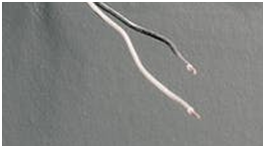What Do Electrical Wire Colors Mean?
2nd Nov 2021
Whether you’re electrically savvy or not, you’ve probably recognized that electrical wires are colored. Specifically, their insulation, the plastic jacket that covers them, is colored, and there’s often a good reason for it.
Lots of things are colored, but with electrical wire, it’s all about telling wires apart. More often than not, there’s nothing different about the electrical wire underneath the color-coded insulation. However, using color-coded wires for different applications in a circuit makes electricians’ jobs easier and improves safety.
Therefore, here are some of the more common colors associated with electrical wire and what they mean, when you see them.
1.Green or bare wires (or occasionally, green-and-yellow)
Whenever you see a green wire, you’re almost certainly looking at a ground wire. That being said, sometimes ground wires are not insulated; less frequently, ground wires may also have a combination of green-and-yellow insulation. Common types of ground wire are insulated, or not insulated, accordingly.
Circuits will operate without ground wires, but ground wires also significantly improve safety, all the same. Most ground wires actually connect the circuit directly to the earth; they are literally in the ground, or “grounded.”
The reason ground wires are typically included in the circuitry of an appliance is to provide a safe exit for excessive electrical potential or current in the event of an overload. If too much voltage was applied to a circuit and that energy had nowhere to go, it would increase the risk of arcing, electrical shock, and overheating the circuit, and causing a fire.
Including ground wires in a circuit (which are frequently green or bare) gives excess electrical energy somewhere to go in the event of an overload - it can be effectively shunted off and into the ground.

2.Black
The color black is commonly used in electrical wiring; it is almost always used to indicate a “hot” or “live” wire. Black wires are commonly used for current-carrying applications such as from the home’s main power supply to the electrical outlets.
Black wires can also be used to run power from switches to outlets and thereby to appliances. Occasionally, black wires are also used as leads for the negative terminal of a battery, in which case they will often be paired with red wires (that serve as leads to the positive terminal).
Whatever the case, extreme caution should be exercised when handling black wires, as it should always be assumed that the wire is “hot” and has the potential to carry current or deliver a shock. Use a multimeter to test a black wire’s potential if you are unsure.
3.Red
Red wires are commonly used as secondary supply wires alongside black wires, which means that red wires, likewise, are nearly always hot. While many appliances will require only a black supply wire, some larger appliances will require a secondary supply wire, which is sometimes red.
Red wires can also be used as hot wires that work to control power to and from a switch within a circuit. For example, an appliance that requires separate power lines for more than one control would need more than one wire. For example, an appliance might need separate power supplies for a motor and a light, in which case color-coded wires (like black and red) would be used to differentiate between them.
Red wires, like black wires, are also very commonly used as leads for batteries, except red wires are used with the connection to the positive terminal. Since red wires, like black wires, are almost always hot, you should use a multimeter to test them if you are unsure of a red wire’s purpose.
4.Orange
Orange wires are often used in the same capacity as red wires, to serve as a secondary power supply line. Although red is probably used more frequently, electricians sometimes pair orange wires with black primary power supply wires.
Orange wires can also be used in alarm systems, in which case they will probably serve as “trigger” wires to cause the entire system to go off when one alarm is triggered. Like red and black wires, orange wires are usually hot, so exercise extreme caution with them.
5.Brown electrical wire
Brown wires are typically used as live, current-carrying wires. While they may be sometimes used as a primary power supply wire, they are more commonly used to carry power between switches, in which case they will likely be referred to as travelers.

6.White or gray
White and gray insulation are typically reserved for neutral wires, but we can only call neutral wires neutral with a caveat. Neutral does not mean that the wires do not carry current. In fact, they often do; the purpose of a neutral wire is to close a circuit so that the current carried by the hot lead from the power supply can flow around it, powering the devices and appliances on the circuit. Without a neutral wire to close the circuit, current wouldn’t be able to flow.
Some electricians also use white and gray wires are hot wires and mark the insulation with colored tape to denote the fact that they’re live. Like other hot wires, you should always exhibit extreme caution when handlnig or otherwise working with white or gray wires; even if they are neutral, they’re probably current-carrying.
7.Blue or yellow
Blue and yellow wires are sometimes use as hot wires, but more often than not, they’re used as traveler wires, much in the same capacity as the brown wires mentioned above. These colored wires are used to conduct power two and from switches, specifically three and four way switches that provide power to an appliance, potentially from multiple locations. While blue and yellow are more common colors for traveler wires, brown and purple are sometimes used for the same purposes.
Contact Us for More Information on Electrical Wire Color-Coding
Do you still have questions about the color-coding used with electrical wires and cables? Don’t be afraid to reach out to us. We’d be happy to answer your questions, and help you choose the proper types of wiring or cable for any electrical project. You can reach us by phone at 800-262-1598 or by email at sales@ewcswire.com.

